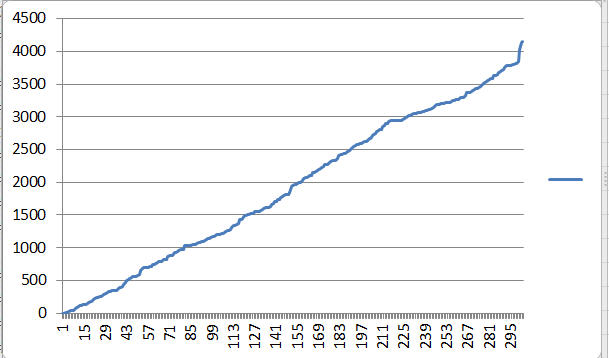I wanted to update with my thoughts on what we are seeing from the CEAC data for Nepal. People keep asking me when the cutoff will fall on Nepal and that cutoff point is critical for Asia as a whole. Let me explain my thoughts.
Currently the CEAC data shows 500 KDU selectees per 1000 case numbers. Not all of the KDU interviews will be Nepalese, but let’s assume they are (almost all will be). So at that rate there would 4000 Nepalese selectees by 8000. Whilst the data shows that Nepal is probably limited in the draw to a high case number of 9100 or so, getting 4000 selectees out of the 4991 selectees is possible because some of the original 4991 will not have responded – so it would make sense that the cases between 8000 and 9100 could have around 500/550 selectees.
OK – so out of the 4000, how many will be approved. DV2014 shows about 10% of Nepal embassy cases are refused, stay on AP or stay at ready. The ready ones at the end of the year are people who give up after submitting their DS260 or sometimes you will see derivatives connected to refused and AP cases (the principal is refused, but the derivatives stay at “Ready” – even though they cannot benefit from the case).
So – if 10% don’t get approved, theoretically the 4000 selectees could be sufficient to hit the limit. That is therefore “possible” by AS8000. At AS7500 it is NOT possible. So – if your number is less than AS7500, please don’t even bother asking whether you are safe or not. Above 7500 there is some risk, the risk increasing as the number gets higher. The final cutoff would be somewhere between 7600 (lowest) to around 8600 (highest). It is not possible to be more precise than that at this time – but of course the longer things go, the more accurate our guesses will be. Up to now I have been thinking the Nepal cutoff would be 8600 to 8800 – but looking at the data I think it could be earlier – so probably in the early 8XXX range.
I am ignoring AOS since that is very small for Nepal. I also note that Nepalese cases are largely not delayed by the DS260 processing – I think that is due to the agents in Nepal doing an efficient job of submitted the forms early in the year.
Now – what does that mean for Asia as a whole. Well, it could re-raise the possibility of a cutoff in August, which means “rest of Asia” would make progress in August and September. As I have explained before, the highest number for rest of Asia still depends on Iranian AP cases. The data shows that Iranians are still highly likely to be put on AP. Most of the Iranian cases are interviewed at Ankara, Abu Dhabi and Yerevan (look for AS region cases at ANK, ABD, YRV in the spreadsheet). It appears as though the AP timing is roughly the same as it was last year. To illustrate that statement take a look at the graph below.
The increase of the number of AP cases among the three embassies processing Iranian cases is more or less linear. That suggests AP is lasting at least 4+ months, otherwise we would see less AP cases in the lower case numbers which would have (mostly) been interviewed earlier on in the year).
So – based on that data it seems likely that AP cases will be as slow to resolve as they were last year. That is bad news for Iranians who get put on AP late in the year, but good news for selectees from the rest of Asia. This would mean Nepal would take around 3500 of the AS quota (8500) and Iran would take something around 2000 to 2500 – leaving 2500+ for the rest of Asia. That should ensure the final AS number will be well above CN10000. It seems unlikely we will see a number as high as last year, but cases in the 10000 to 12000 range have a pretty good chance.
Update regarding Nepal and Asia


May 15, 2019 at 20:29
Hi simon I am from nepal & I’m selected for edv 2020 & my case is 78**. Do I have chance for interview.waiting for your response.
May 16, 2019 at 03:50
Too early to know.
https://britsimonsays.com/dv2020-basic-questions/
June 9, 2019 at 17:22
Hy brit ,
Actually m edv 2020 winner from Nepal
I saw case no of Asia is very high compare to previous year .what does it mean? More holes or more winner ?
Nepal has 22k case no this year.
Is there any chances for case no around 13000 ?
June 9, 2019 at 19:56
We don’t know what it means yet. When we see the selectee counts we will know more.
September 28, 2019 at 15:15
Hey Aakriti, any update?
My case no is as similar as yours.
July 1, 2019 at 15:18
Hi Brit
My Case Number is 9500
And I applied DS-260 fourm .. so can I get second letter..
July 1, 2019 at 23:38
Year, region?
September 6, 2019 at 18:19
Hy brit
Thank you for your guidance
i m from sri lanka ,my case no is around 13.5k
My husband is currently living in Thailand . I m also planning to move there after few month ,
1 . actually we are planning to schedule our interview in Thailand bt we had chosen our interview location in Sri Lanka while we filled up ds260 form .
Can we change our interview location ?
2. According to dv process , if you stay another country more than 6 month , you need to show your police clearance report. So my question is , Is there is neccessary to have police clearance report of Thailand
when you already submitted your police clearance report of sri Lanka to kcc?
Thank you in advance ???
September 7, 2019 at 05:03
1. It is based on your current address.
2. You simply follow the instructions.
September 16, 2019 at 01:43
hi brit , my case number is as141xx and I’m from nepal.there is any chance for interview?
September 16, 2019 at 02:50
Yes, patience.
September 23, 2019 at 14:36
Thanks sir. How many vissas are avaible for nepal in 2020.can you tell me please!
September 23, 2019 at 19:49
Exclamation marks should be used only when necessary!
Visas are not allocated to any country – including Nepal. So – they get as many visas as they need based on the cases they have. However, there is a rule that says NO country can receive more than 7% of the GLOBAL number of visas. So – that means there is a hard stop at 3850 visas.
September 24, 2019 at 00:20
Thank you sir.
November 11, 2019 at 05:19
Hello sir
Mine case no is 13043,,from Nepal got to know that won dv on october only so what are the probability to get 2nd letter..
November 11, 2019 at 16:33
It’s fine. Just be patient.
July 5, 2020 at 12:10
Dear brit, My case number is AS95** from Nepal.
Do i have chances of getting interview?
what is the highest case number that you ve heard from Nepal?
Thank you for your wonderful work.
July 5, 2020 at 15:33
Always quote the year!
Assuming 2021, it is too early to know anything.